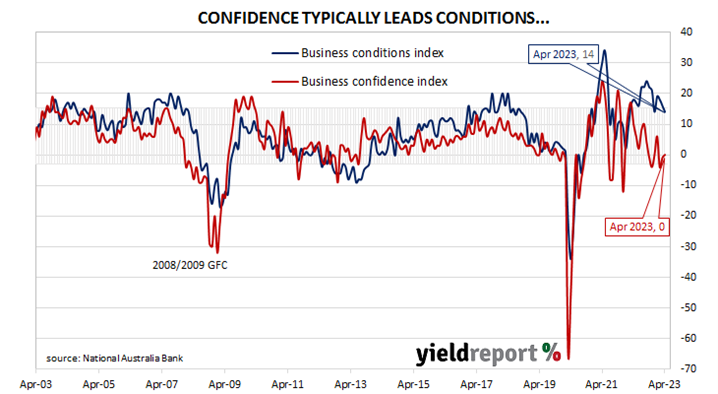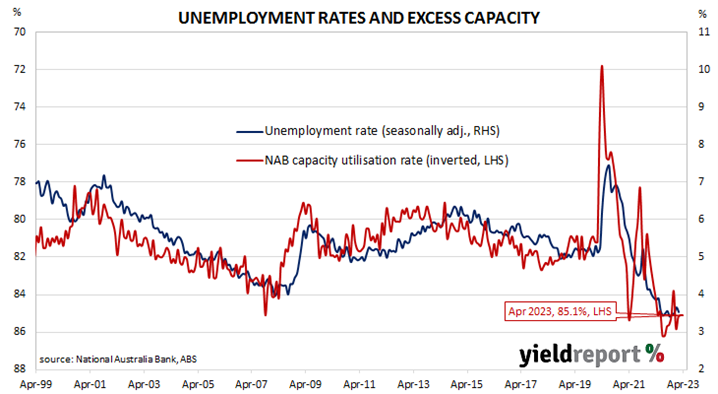Summary: Business conditions slip again in April; survey shows “economy remains resilient”; confidence improves again; Westpac: “business mood remains fragile”; capacity utilisation rate steady, remains elevated.
NAB’s business survey indicated Australian business conditions were robust in the first half of 2018, with a cyclical-peak reached in April of that year. Readings from NAB’s index then began to slip and forecasts of a slowdown in the domestic economy began to emerge in the first half of 2019 as the index trended lower. It hit a nadir in April 2020 as pandemic restrictions were introduced but then conditions improved markedly over the next twelve months. Subsequent readings were generally in a historically-normal range until the second half of 2022.
According to NAB’s latest monthly business survey of over 400 firms conducted in last week of April, business conditions have slipped modestly for a third consecutive month while remaining at a historically high level. NAB’s conditions index registered 14 points, down 2 points from March’s reading.
In contrast, business confidence improved a little more after March’s modest increase. NAB’s confidence index rose from March’s reading of -1 point to zero, still below the long-term average. Typically, NAB’s confidence index leads the conditions index by one month, although some divergences have appeared from time to time.
“Overall, the survey shows the economy remains resilient,” said NAB Chief Economist Alan Oster. “We continue to expect consumption growth to slow as the effect of higher rates further impacts households, but how quickly and how sharply this occurs remains uncertain.”
Commonwealth Government bond yields rose materially on the day following strong rises in US Treasury yields on Friday night. By the close of business, the 3-year ACGB yield had gained 11bps to 3.05%, the 10-year yield had added 8bps to 3.40%, while the 20-year yield finished 6bps higher at 3.86%.
In the cash futures market, expectations regarding rate cuts in 2024 softened. At the end of the day, contracts implied the cash rate would remain essentially steady at the current rate of 3.82% to average 3.83% in June and 3.86% in July. February 2024 contracts implied a 3.63% average cash rate while May 2024 contracts implied 3.46%, 36bps less than the current rate.
Westpac senior economist Andrew Hanlan sounded somewhat less positive in his view of the figures. “The cooling of business conditions has extended into the June quarter and the business mood remains fragile and soft as the flow of new orders dries up.”
NAB’s measure of national capacity utilisation remained at the historically-elevated level of 85.1%. All eight sectors of the economy were reported to be operating above their respective long-run averages.
Capacity utilisation is generally accepted as an indicator of future investment expenditure and it also has a strong inverse relationship with Australia’s unemployment rate.



